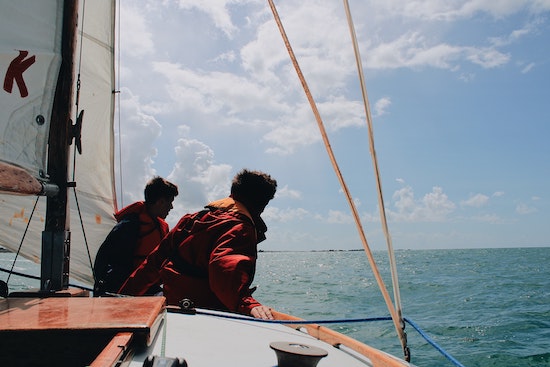Whether you have always dreamt of gracefully gliding across the open waters or simply want to embark on a new adventure, learning how to sail is an exciting and rewarding journey. If you are wondering if it is possible to teach yourself to sail, the answer is a resounding “yes!” Sailing is a skill that can be self-taught, allowing you to enjoy the freedom of the sea at your own pace. We will walk you through the basics of sailing, share tips on getting started, and highlight the essential skills you should learn first. So, grab your maritime curiosity, hoist your sails of enthusiasm, and let’s set sail into the world of sailing!
Introduction
Sailing is a thrilling and rewarding activity that allows you to explore the beauty of the open water while harnessing the power of the wind. If you’re new to sailing and eager to learn how to get started, you’ve come to the right place. we will guide you through the essential steps to sail for beginners.
Firstly, it’s important to understand the basic terminology used in sailing. Familiarize yourself with terms such as port (left side of the boat when facing forward) and starboard (right side of the boat when facing forward). Additionally, learn about the different parts of a sailboat, including the mast, hull, keel, and rudder. Understanding these terms will help you navigate the world of sailing with ease.
Once you have a good grasp of the sailing lingo and boat components, it’s time to get hands-on experience. Consider enrolling in a sailing course or joining a sailing club in your area. These resources will provide you with knowledgeable instructors who can teach you the fundamentals of sailing, including how to hoist and trim sails, steer the boat, and navigate using wind direction. Learning from experts will help you develop proper technique and build confidence on the water.
-
- Start with small boats:
When starting out, it’s recommended to learn on small sailboats, such as dinghies or small keelboats. These boats are more responsive to your actions and allow you to understand the impact of your movements on the boat’s behavior. You’ll gain a better sense of balance and learn to adjust your weight to counteract the force of the wind.
-
- Practice basic maneuvers:
Once you’re comfortable with the fundamentals, it’s time to practice basic maneuvers. Begin by sailing close-hauled, which means sailing as close to the wind as possible. This will help you understand how the wind interacts with your sails and how to adjust them to achieve optimal speed and direction. As you progress, practice tacking (turning the bow of the boat through the wind) and jibing (turning the stern of the boat through the wind) to change your direction efficiently.
-
- Learn to read the wind:
An essential skill in sailing is being able to read the wind. Observe the ripples on the water’s surface, the movement of nearby flags, or the behavior of other boats to gauge wind direction and intensity. By understanding the wind patterns, you can plan your maneuvers and make adjustments to maximize your sailing experience.
Can I Teach Myself to Sail?
Sailing is a fascinating and exhilarating activity that allows you to navigate the open waters, harnessing the power of the wind to propel your vessel. If you’re considering taking up sailing as a hobby or are intrigued by the idea of exploring the seas independently, you may be wondering if it’s possible to teach yourself how to sail. While having experienced instructors and formal training can undoubtedly be beneficial, it is indeed possible to learn the basics of sailing on your own.
So, how can you teach yourself to sail?
- Start with the fundamentals: Before setting sail, it’s crucial to familiarize yourself with the basic concepts of sailing. This includes understanding the different parts of a sailboat, mastering the terminology used in sailing, and learning how to interpret wind direction and strength.
- Study sailing theory: To gain a solid understanding of sailing, consider immersing yourself in sailing theory. There are numerous online resources, books, and even video tutorials available that cover topics such as sail trim, points of sail, navigational rules, and safety guidelines.
- Practice on smaller boats: It’s advisable to start your sailing journey on smaller boats, such as dinghies or small sailboats. These vessels are more responsive and forgiving, allowing you to build your confidence and improve your skills before moving on to larger boats.
While self-teaching sailing is possible, it’s important to remember the following:
- Always prioritize safety: Sailing can be a thrilling adventure, but safety should never be overlooked. Familiarize yourself with safety protocols, such as wearing appropriate life jackets, understanding navigation rules, and checking weather conditions before setting sail.
- Consider joining a sailing community: Connecting with other sailors can provide valuable insights, tips, and support as you navigate your sailing journey. Joining a local sailing club or participating in sailing events and regattas can help you expand your knowledge and meet experienced sailors who can offer guidance.
- Seek professional guidance if needed: While self-teaching can be a rewarding experience, there may come a time when assistance from a professional sailing instructor becomes necessary. They can help refine your skills, provide advanced techniques, and ensure you have a comprehensive understanding of sailing.
| Advantages of teaching yourself to sail: | Disadvantages of teaching yourself to sail: |
|---|---|
|
|
How Do I Get Started in Sailing?
Sailing is a fascinating and exhilarating activity that allows you to enjoy the open waters and connect with nature. If you’ve ever wondered how to get started in sailing, you’re in the right place. Whether you have dreams of sailing around the world or simply want to enjoy a weekend hobby, we will provide you with valuable information to kickstart your sailing journey.
Research and Gain Knowledge: Before embarking on your sailing adventure, it’s important to do some research and gain a basic understanding of sailing principles. Familiarize yourself with sailing terminology, basic navigation techniques, and safety guidelines. There are numerous online resources, sailing forums, and books that can provide you with a solid foundation of knowledge.
Take a Sailing Course: Once you have a theoretical understanding of sailing, it’s time to put that knowledge into practice. Consider enrolling in a sailing course at a certified sailing school or yacht club. These courses are designed for beginners and will provide you with hands-on experience and guidance from experienced instructors. They will teach you essential skills such as steering, trimming sails, and docking.
Join a Sailing Club: Joining a sailing club or community can significantly enhance your sailing journey. It provides you with opportunities to meet experienced sailors, participate in group outings, and learn from their expertise. Sailing clubs often host workshops, races, and social events, creating a supportive network of fellow enthusiasts who can help you improve your skills and knowledge.
Invest in Personal Safety: Safety should always be a top priority when sailing. Invest in proper safety gear, such as life jackets, safety harnesses, and signaling devices. Additionally, familiarize yourself with the safety procedures specific to your sailing location. Knowing how to respond to emergencies and adverse weather conditions can help you navigate challenging situations with confidence.
Practice, Practice, Practice: Sailing, like any skill, requires practice and dedication. Take every opportunity you can to get out on the water, whether it’s through renting a boat, crewing for someone else, or joining sailing events. The more time you spend practicing, the more comfortable and competent you will become.
Set Sailing Goals: Setting goals can help keep you motivated and focused on your sailing journey. Whether it’s mastering a new maneuver, sailing to a specific destination, or participating in a race, having goals gives you a sense of purpose and accomplishment. Start with achievable short-term goals and gradually work towards more ambitious ones.
What Should I Learn First About Sailing?
When it comes to learning how to sail, it’s important to start with the fundamentals. Understanding the basics of sailing will not only help you navigate the waters, but also ensure your safety and enjoyment on the open sea. So, what should you learn first about sailing? Let’s dive in and explore the key elements.
1. Sail Terminology: Familiarizing yourself with the different parts of a sailboat is essential. Learn the names of the various sails, such as the mainsail, jib, and spinnaker. Additionally, understand the terms used to describe different directions and angles, such as port (left) and starboard (right), and the different points of sail, such as upwind and downwind.
2. Rigging and Knots: Becoming proficient in rigging a sailboat and tying knots is crucial. Practice tying essential knots like the bowline and figure-eight knot. These skills will enable you to secure your sails and handle lines effectively. Understanding how to properly rig your boat ensures the sails are set correctly and the boat is safe and stable.
3. Wind Awareness: Sailing revolves around wind, so developing a keen sense of wind awareness is paramount. Learn to observe and understand the wind direction and speed, as well as its impact on your sails. This knowledge will help you navigate efficiently and make adjustments to optimize your speed and maneuverability.
4. Points of Sail:
Knowing the different points of sail is essential for understanding how to position your sails in relation to the wind. The three main points of sail are upwind, downwind, and reaching. Each point of sail requires a different sail configuration and boat position. Mastering these concepts will enable you to sail in any direction efficiently.
5. Safety Precautions:
Before setting sail, it’s crucial to prioritize safety. Learn about essential safety precautions, such as wearing a life jacket, checking weather conditions, and understanding basic navigation rules. Familiarize yourself with emergency procedures, including man overboard drills. Always be prepared for unexpected situations to ensure a safe and enjoyable sailing experience.
| Pros: | Cons: | Tips: |
|---|---|---|
| • Sailing offers an exhilarating and unique way to explore the world’s waterways. | • Requires ongoing learning and practice to become proficient. | • Take sailing lessons from an experienced instructor for a solid foundation. |
| • It’s a sustainable and eco-friendly mode of transportation. | • Can be physically demanding and require teamwork. | • Join a sailing club or find a mentor to gain practical experience. |
| • Provides opportunities for adventure and travel. | • Weather conditions can be unpredictable and challenging to navigate. | • Start with smaller boats and gradually progress to larger vessels. |
What Are the Basics of Sailing?
When it comes to sailing, understanding the basics is crucial for a successful and enjoyable experience on the water. Whether you’re a complete beginner or have some experience, it’s always a good idea to review the fundamentals. We will explore the essential aspects of sailing that every sailor should know.
1. Types of Sailboats
Before diving into the basics, it’s important to familiarize yourself with the different types of sailboats available. Sailboats can vary in size, design, and purpose. From dinghies and keelboats to catamarans and yachts, each type offers unique characteristics and sailing experiences.
2. Understanding the Wind
Wind plays a pivotal role in sailing, and understanding its behavior is essential. The wind direction will determine the course you can sail, while its speed will impact the power and speed of your boat. Beginners should learn how to read wind indicators, such as wind socks or flags, to gauge wind direction and adjust their sails accordingly.
3. Sail Terminology
Learning the basic sail terminology is essential for effective communication and maneuvering on the water. Here are a few key terms to get you started:
- Mainsail: The primary sail on a sailboat, typically attached to the mast.
- Jib: A smaller triangular sail that is often located in front of the mast.
- Tack: The lower forward corner of a sail.
- Sheet: The line used to adjust the angle of the sail in relation to the wind.
- Boom: The horizontal pole that extends the foot of the mainsail.
4. Points of Sail
Understanding the different points of sail is crucial for navigating your sailboat effectively. The points of sail refer to the direction in which the wind is coming relative to your boat. The main points of sail include:
- Upwind (close-hauled): Sailing against the wind’s direction.
- Beam reach: Sailing perpendicular to the wind.
- Broad reach: Sailing with the wind slightly behind your boat.
- Downwind (running): Sailing directly with the wind at your back.
5. Basic Maneuvers
Mastering a few basic maneuvers will greatly enhance your sailing skills. Some essential maneuvers to learn include tacking (changing direction while sailing into the wind) and jibing (changing direction while sailing away from the wind). These maneuvers require coordinated sail adjustments and careful steering.
By understanding these basic aspects of sailing, you’ll be well on your way to becoming a competent sailor. Remember, practice makes perfect, so get out on the water, experiment, and continue learning from your experiences. Happy sailing!










